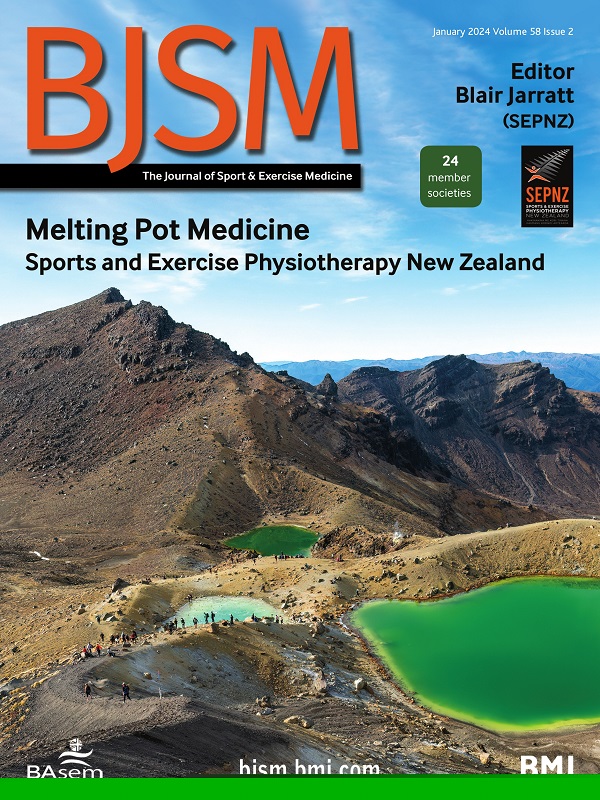跑多久算多?在一项5200人的队列研究中确定高风险跑步时段
IF 16.2
1区 医学
Q1 SPORT SCIENCES
引用次数: 0
摘要
目的:我们探索与前一段时间相比,单次或超过一周的跑步距离峰值是否与跑步相关的过度使用损伤风险增加有关。方法招募成年跑步者进行为期18个月的队列研究。使用Garmin装置收集的数据,根据跑步距离的相对变化定义了三种与训练相关的暴露:(1)相对于过去30天内最长距离的特定阶段跑步距离;(2)使用急性:慢性工作负荷比(ACWR)相对于前3周的1周;(3)采用周对周比率的1周期间。跑步者被分为四种时变状态之一:(1)回归,或高达10%的增长(参考);(2)增幅在10% ~ 30%之间的“小峰值”;(3)增幅在30% ~ 100%之间出现“中等峰值”;(4)“大峰值”100%增长。结果是自我报告的过度使用跑步相关损伤。采用多状态Cox回归模型估计校正危险率比(HRR)。结果5205名跑步者平均年龄45.8岁,SD=10.4;22%的女性),在588071次比赛中,共有1820人(35%)遭受了与跑步有关的伤害。小尖峰(HRR=1.64 (95% CI: 1.31 ~ 2.05, p=0.01))、中等尖峰(HRR=1.52 (95% CI: 1.16 ~ 2.00, p<0.01))和大尖峰(HRR=2.28 (95% CI: 1.50 ~ 3.48, p<0.01))的单段跑步距离的发生率显著增加。ACWR呈负剂量-反应关系。没有发现周与周之间的关系。结论在最近30天内,单次跑步距离超过最长跑步距离的10%时,与跑步相关的过度使用损伤的发生率显著增加。根据知情同意书,任何数据都不能在奥胡斯大学之外共享。本文章由计算机程序翻译,如有差异,请以英文原文为准。
How much running is too much? Identifying high-risk running sessions in a 5200-person cohort study
Objectives We explored whether a spike in running distance during a single session or over 1 week, compared with the preceding period, was associated with increased risk of running-related overuse injury. Methods Adult runners were recruited for an 18-month cohort study. Three training-related exposures were defined based on a relative change in running distance, using data collected via Garmin devices: (1) session-specific running distance relative to the longest distance run in the past 30 days; (2) 1-week period relative to the preceding 3 weeks using the acute:chronic workload ratio (ACWR); (3) 1-week period using a week-to-week ratio. Runners were categorised into one of four time-varying states: (1) regression, or up to 10% increase (reference); (2) ‘small spike’ between >10% and 30% increase; (3) ‘moderate spike’ between >30% and 100% increase; and (4) ‘large spike’ >100% increase. Outcome was self-reported overuse running-related injury. A multistate Cox regression model was used to estimate adjusted hazard rate ratios (HRR). Results Among 5205 runners (mean age 45.8 years, SD=10.4; 22% female), a total of 1820 (35%) sustained a running-related injury during 588 071 sessions. Significantly increased rates were identified for small spikes (HRR=1.64 (95% CI: 1.31 to 2.05, p=0.01)), moderate spikes (HRR=1.52 (95% CI: 1.16 to 2.00, p<0.01)) and large spikes (HRR=2.28 (95% CI: 1.50 to 3.48, p<0.01)) in single-session running distance. A negative dose-response relationship was observed for the ACWR. No relationship was identified for the week-to-week ratio. Conclusion A significant increase in the rate of running-related overuse injury was found when the distance of a single running session exceeded 10% of the longest run undertaken in the last 30 days. According to the informed consent, no data can be shared outside Aarhus University.
求助全文
通过发布文献求助,成功后即可免费获取论文全文。
去求助
来源期刊
CiteScore
27.10
自引率
4.90%
发文量
217
审稿时长
3-8 weeks
期刊介绍:
The British Journal of Sports Medicine (BJSM) is a dynamic platform that presents groundbreaking research, thought-provoking reviews, and meaningful discussions on sport and exercise medicine. Our focus encompasses various clinically-relevant aspects such as physiotherapy, physical therapy, and rehabilitation. With an aim to foster innovation, education, and knowledge translation, we strive to bridge the gap between research and practical implementation in the field. Our multi-media approach, including web, print, video, and audio resources, along with our active presence on social media, connects a global community of healthcare professionals dedicated to treating active individuals.

 求助内容:
求助内容: 应助结果提醒方式:
应助结果提醒方式:


